
42 minute read
Top Issue: Buildings
Activate the River
Issue Community members want a vibrant downtown that serves as a regular destination for locals. Across the community, public input participants indicated that Hawkinsville 3 could benefit from active social businesses like cafes, an ice cream parlor, a brewery, or similar establishments that could act as a neighborhood anchor and bring activity to downtown after 5:00. Locals want a downtown that offers variety and life, with plenty to see and do throughout the day and into the evening hours. Public input participants indicated that Hawkinsville could benefit from expanded public spaces and outdoor activities like food trucks, outdoor music events, sidewalk dining, and other programming that could attract residents from across the community downtown. Through regular events and activities that bring life to underutilized areas like vacant lots, community members want to reestablish downtown as the heart and soul of the community. Moving forward, the city and local partners should continue to support places and events that already bring the community downtown and should work to grow venues that attract local residents and families.
Issue Hawkinsville residents see the city’s location along the Ocmulgee River as a unique asset and untapped resource that sets the city apart. Indeed, Hawkinsville was founded 4 because of the city’s site along the Ocmulgee and served as a bustling river port for many decades. Already, public areas like Veterans Park and the Uchee Shoals Boat Landing attract residents and visitors to this impressive natural resource. Many public input participants favored improving and expanding access to public spaces along the river. Local residents in step one of the Hawkinsville RSVP also saw the opportunity to attract businesses like a river outfitter to bring a variety of activities to the riverfront. Encouraging riverfront activities like kayaking or recruiting a riverfront brewery or other destination could help make downtown a more diverse and appealing attraction in future years.
Buildings:
CONDITION & VACANCY
ith a history dating back to the early 1800s, Hawkinsville boasts a wealth of historical commercial, industrial, residential, and institutional buildings. These buildings are reminders of Hawkinsville’s rich history and heritage. While residents are proud of their history and praised the city’s architecture throughout step one of the Hawkinsville RSVP planning process, they overwhelmingly noted that building condition, vacancy, maintenance, and incentivizing redevelopment are the most pressing issues facing downtown. More than any other issue, Hawkinsville residents are united in the belief that improving the appearance of buildings, maintaining existing properties, and addressing the high rate of downtown vacancies must be prioritized to restore downtown as the vibrant heart of the community.
According to the city’s 2020 Rural Zone application compiled with assistance from the Middle Georgia Regional Commission (MGRC), of the 120 parcels downtown, 38 include vacant structures. This amounts to a downtown vacancy rate of 31.7%. These figures only reflect vacant buildings; when including vacant lots and parking lots, the rate of vacancy downtown is above 47%. Empty and unmaintained buildings send a negative signal to visitors, stunt attempts at reinvestment, and punish adjacent property owners who try to maintain their properties.
With nearly half of downtown properties vacant or underutilized, Hawkinsville leaders must boldly address blight and vacancy to realize the future downtown envisioned by its citizens. Local residents often pointed to the revival of nearby downtown Perry, Georgia, as an example and cited both ordinances and incentives that have revitalized that city’s now-bustling downtown. As seen in Perry’s corridor development ordinance, proper codes help ensure an adequate level of maintenance, hold negligent property owners accountable, and can incentivize the type of attractive new development desired by the community.

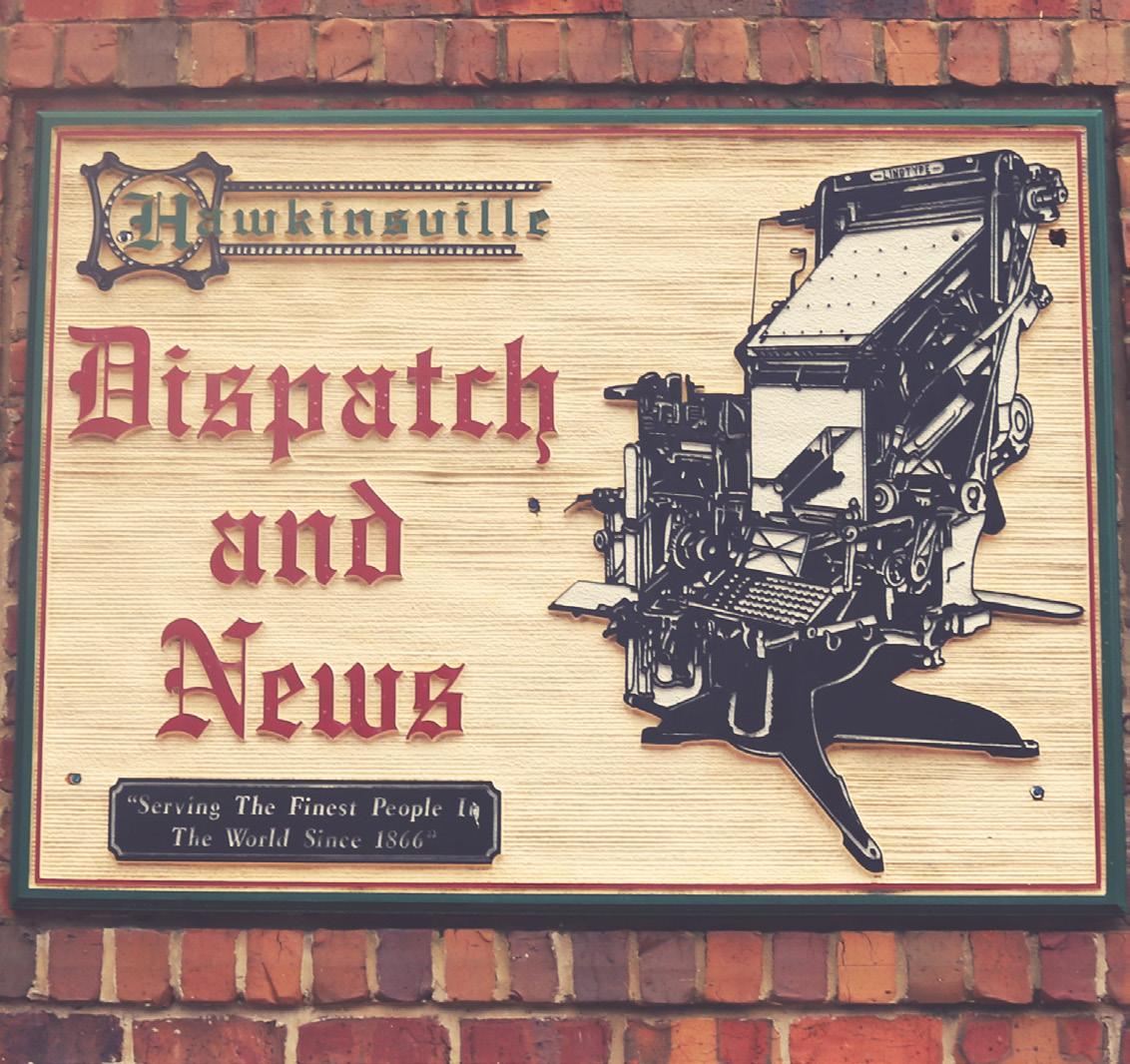

To attract the investment necessary to revitalize downtown Hawkinsville, the community overwhelmingly supports a muscular city response to substandard building maintenance and issues of vacancy and neglect. Prior to any other improvements, local officials must confront this critical issue head on. According to the 2020 Rural Zone application developed by the city and the MGRC, 12.5% of all downtown parcels are blighted. If local leaders defer confronting this issue, Hawkinsville risks losing more historic structures to blight. Without code enforcement targeting blight, investors will have no financial motivation for renovating downtown businesses. When buildings are allowed to decline to a state beyond what is financially or structurally possible to repair, important elements of the city’s character are forever lost.
In dense downtown areas, blocks of buildings provide the first impression of the community to visitors and residents. Tightly spaced, often historic downtown buildings are like the smile Hawkinsville offers to the world. Demolition by neglect leaves visible gaps just like a missing tooth in a smile, and begins to erode the cohesive appearance and function of downtown. Stemming the tide of blight with early intervention is essential if Hawkinsville leaders want to leave the next generation a downtown worth living and doing business in. Local leaders should take action to prevent additional demolition and work to fill the gaps already carved downtown by neglect. To meet this challenge, Hawkinsville should look to other cities across the state and beyond, adopting the redevelopment tools, incentives, and ordinances necessary to bring desired change downtown. Local leaders should consider appropriate tools including an abandoned property registry similar to Powder Springs’ Vacant Property Registration Ordinance or a blight tax similar to Cornelia’s Community Redevelopment Tax Incentive Program to get serious about restoring and revitalizing downtown properties.
Ordinances help ensure that all downtown property owners play by the same rules to protect the investments of downtown small businesses and property owners.
While developing the mechanisms to respond to this challenge, city and local government must look inward first and improve the appearance and maintenance of publicly owned property. Local officials must ensure that government offices maintain a high standard of property maintenance. It would be hypocritical to create codes targeting property owners while turning a blind eye to the conditions of public buildings and infrastructure.
Public buildings help set a standard for surrounding private businesses and properties. While most public buildings, including the county courthouse, are attractive and well maintained, other government offices, parks, and public spaces are in need of significant maintenance. Focusing on public property and addressing necessary maintenance of city- and county-owned parcels, including vacant city-owned lots, the Pulaski County Emergency Management annex, and public assets like Cabero Park is an essential first step in creating a downtown that feels worthy of outside investment.
To create an environment where business owners, visitors, and local citizens all feel safe, secure, and comfortable investing time and money downtown, building maintenance and attacking blight must be Hawkinsville’s top priority. Efforts to improve downtown properties should begin with a thorough, block-by-block downtown audit indicating missing street trees, broken street lights, deteriorating sidewalks, unmaintained public areas, and more. Targeting public properties for improvement first could establish a high standard of maintenance for surrounding downtown businesses.
To successfully shape the vibrant downtown desired by residents, enforcement mechanisms should be paired with a robust variety of incentives that encourage property rehabilitation and business growth downtown. As many owners of older homes and properties can attest, restoring and properly maintaining historical properties often comes with a heavy financial burden. Many residents cited facade grants as a public investment that has benefited property owners and significantly improved the appearance of downtown storefronts. Residents would like to see this program expanded and supplemented with a variety of redevelopment incentives. In addition to expanding existing programs, local leaders should examine the tools that have worked in other communities, including rear facade grants, sprinkler grants, signage grants, tax abatement programs, and other examples.
Local leaders should consider bold, creative solutions to create the vibrant downtown desired by local residents. Under Georgia law, downtown development authorities (DDAs) already possess wide powers to purchase, rehabilitate, and sell or lease property. Local leaders should consider emulating the example of downtown Bainbridge, where that city’s DDA has revitalized formerly vacant downtown properties using the tools available to the DDA and the assistance of convict trustee labor. With an abundance of vacant or abandoned property, Hawkinsville should also consider developing a land bank and charitable 501(c)(3) for property donations. Major cities, including Buffalo and St. Louis, have gone to extreme measures, developing programs to sell vacant land and properties to new homeowners committed to renovation. Many of these properties are available for as little as $1 but require prospective property owners to rehabilitate the property and remain in the home for a minimum of three years. To attract the type of redevelopment desired by the community, city and county leaders should view downtown redevelopment like they view industrial recruitment: Aggressively pursuing the type and quality of development desired could forever change the community for the better.
To determine what incentives make sense in the community, Hawkinsville officials should work with property and business owners and groups like the Hawkinsville–Pulaski County Chamber of Commerce and Hawkinsville-Pulaski Economic Development to understand issues faced by downtown property owners. Ensuring that local officials and business owners are aware of the tools available to them is a critical first step in addressing building maintenance and restoration downtown. Hawkinsville’s Rural Zone designation, in particular, offers significant benefits to property and business owners, including a job tax credit, investment credit, and rehabilitation credit for property improvements. As part of this planning effort, designers and planners at the Institute of Government developed a custom guide to existing incentives that showcases the tools already offered by the community. Distributing this information to existing property owners and potential investors could ensure all stakeholders are informed about the tools available to assist with downtown revitalization.
Broken Windows Theory
In 1982, George L. Kelling and James Q. Wilson wrote, “Social psychologists and police officers agree that if a window in a building is broken and left unrepaired, all the rest of the windows will soon be broken … one unrepaired broken window is a signal that no one cares, and so breaking more windows costs nothing.”
Since the early 1980s, the “broken windows” theory developed by Kelling and Wilson has drastically changed downtowns and neighborhoods across the nation. By establishing that unchecked property decline allows crime to fester, the broken windows theory created an easily understood and compelling argument for controlling blight.1
The relationship between high vacancy rates and an increased incidence of crime has been corroborated by a number of other sources. A decade-long study of properties in Philadelphia showed that clearing vacant lots of trash and debris and improving otherwise vacant properties with plantings reduced nearby incidents of violent crime by 5%. An even more impressive 39% reduction in crime was noted when abandoned buildings were renovated and occupied. Another study published in the American Journal of Public Health noted that “simple treatments of abandoned buildings and vacant lots returned between $5.00 and $26.00 in net benefits to taxpayers and between $79.00 and $333.00 to society at large, for every dollar investment.”2 A follow-up piece in The New Yorker noted that given these outcomes, “It’s not only more dangerous to leave [vacant] properties untended—it’s more expensive.”3

1. Shankar Vendantam. 2016, November 1. “How A Theory of Crime and Policing Was Born, and Went Terribly Wrong.” Hidden Brain, National Public Radio. Transcript. https://n.pr/3uAYzLe 2. Ruth Moyer, John M. MacDonald, Greg Ridgeway, and Charles C. Branas. 2018, December 19. “Effect of Remediating Blighted Vacant Land on Shootings: A Citywide Cluster Randomized Trial.” American Journal of Public Health 109, 140–144. https://bit.ly/3t2rFm5 3. Eric Klinenberg. 2018, August 23. “The Other Side of ‘Broken Windows’.” The New Yorker. https://bit.ly/31Xq5Gr

EXISTING | Located just past the new bridge, the former service station is the first impression of downtown for visitors arriving from the east.
PROPOSED, SHORT TERM | Cleaning up this property and installing branded signage could provide visitors with a more positive impression of downtown.

PROPOSED, LONG TERM With a location near the Ocmulgee River, this former service station could eventually serve as a river outfitters. Businesses that take advantage of Hawkinsville’s riverfront location could help attract a variety of regular activity downtown.



PROPOSED Local leaders are in discussions with the new owners of this property. This rendering envisions this site as home of a new brewpub.



EXISTING | The prominent vacant property at the corner of Houston and Commerce Street was frequently cited as needing improvement in step one of the RSVP process.

PROPOSED Repainting this building, repairing windows, and installing attractive signage and new plantings refreshes the appearance of this historic property.


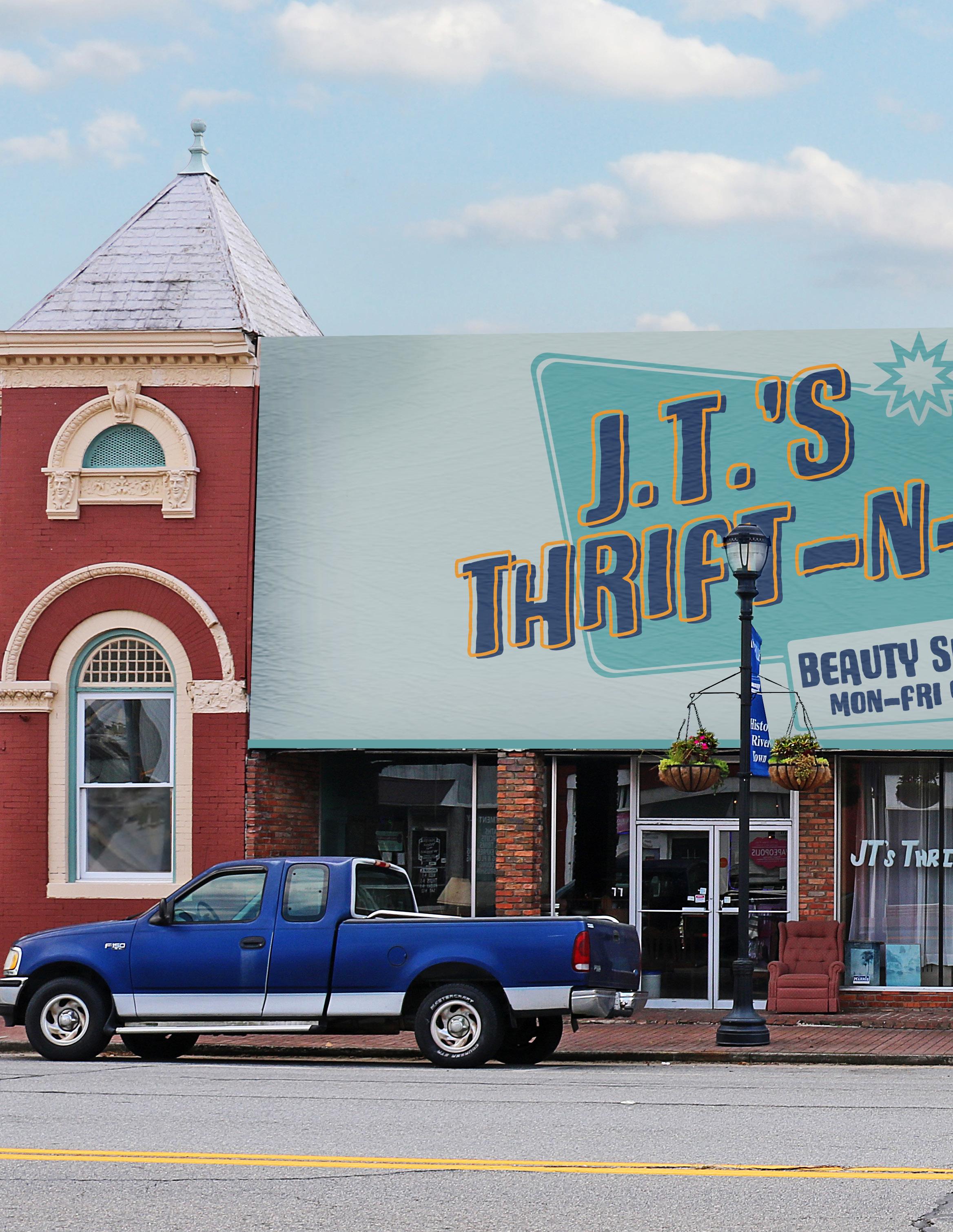

EXISTING | The crumbling plasterwork of this midcentury facade sends a negative signal to visitors.
PROPOSED Fresh paint and stylized 1950s-inspired hand-painted signage emphasize the midcentury character of this prominent building.

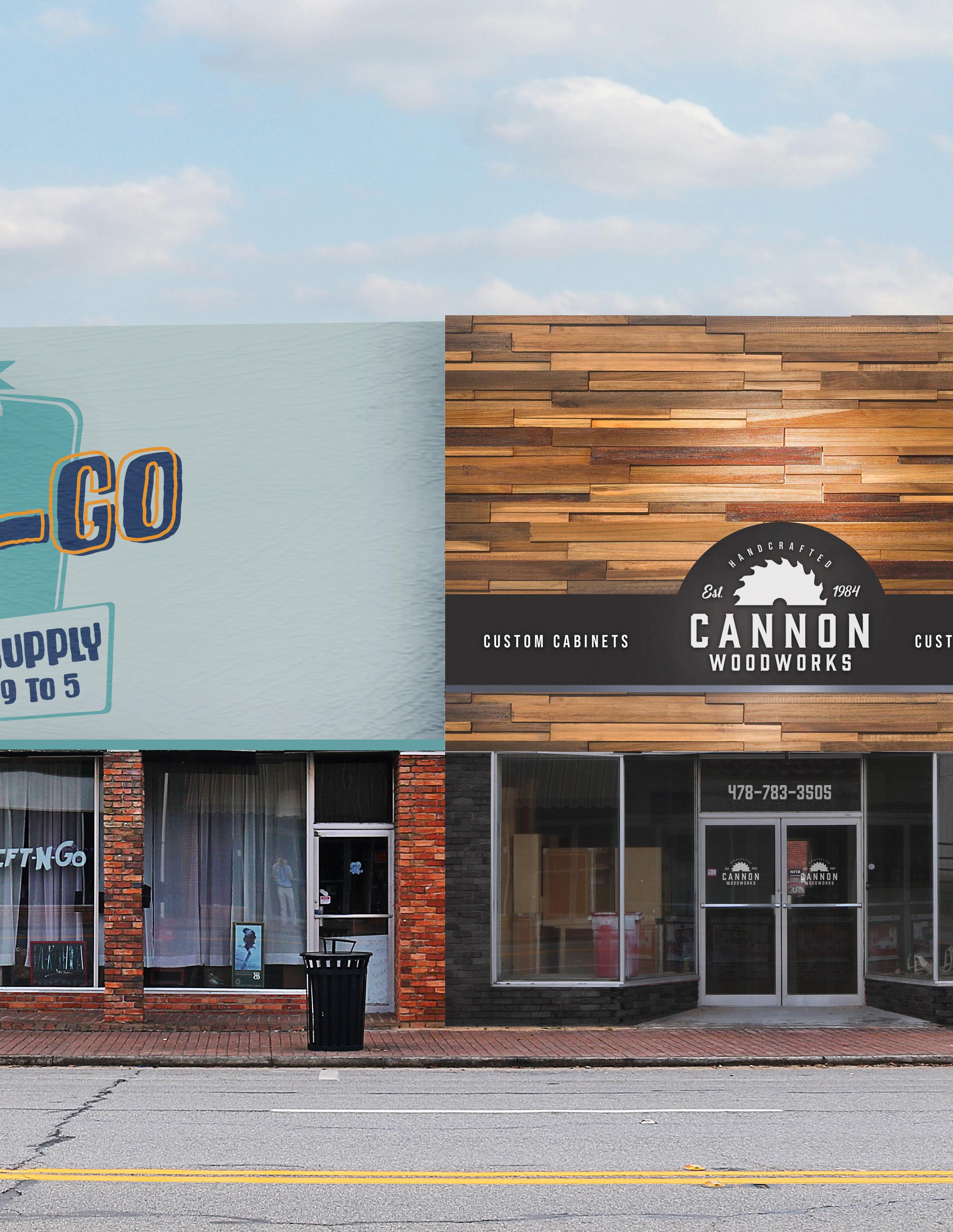

EXISTING | The tired facade housing Cannon WoodWorks downtown could benefit from improvement.

PROPOSED This facade could help showcase the talented carpenters at Cannon WoodWorks. This unique wood-plank facade is highlighted by fresh black paint and crisp custom signage.

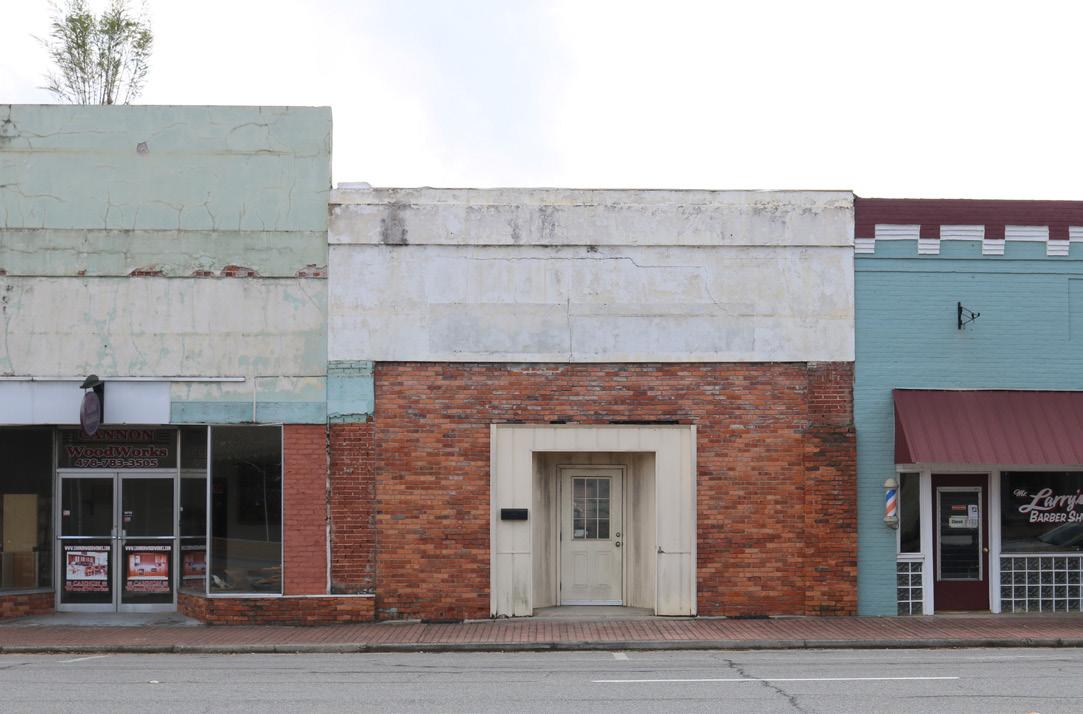
EXISTING | The windowless front facade at 81 Commerce Street offers a blank slate for potential investors.


PROPOSED Elegant black and white paint, a traditional striped awning, and gold lettering transform this downtown building. Handsome lanterns and a new glass door illuminate this facade.

EXISTING | The midcentury building at 97 Commerce Street will soon host a downtown restaurant, the Florida Room.

PROPOSED
Inspired by the structure’s simple midcentury aesthetic and the tropical vibe of the Florida Room, this bold handpainted facade invites patrons and provides a cheery new presence downtown.


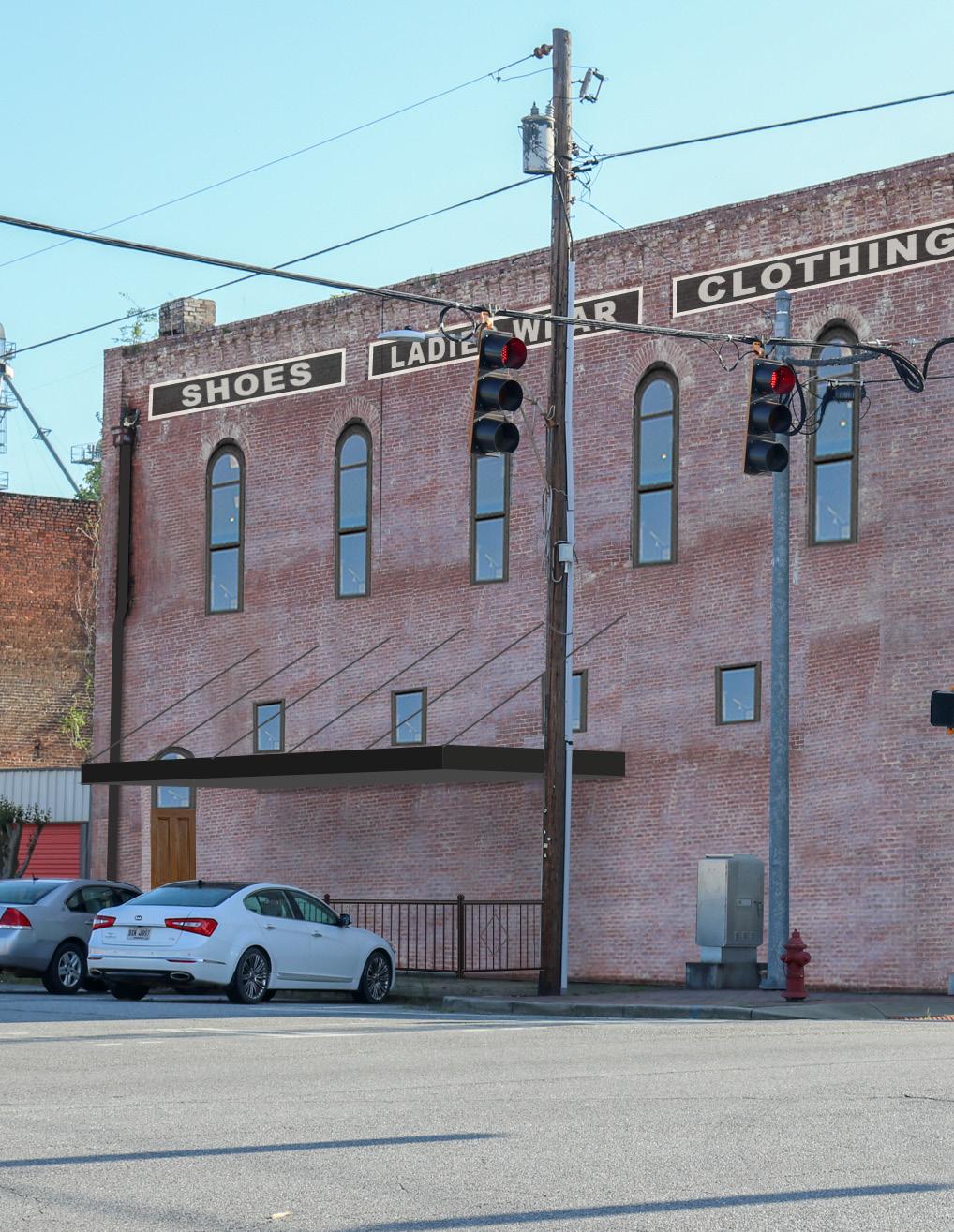

EXISTING | This angled image shows the building at the corner of Jackson Street and Commerce Street in downtown Hawkinsville. This historic building has seen many alterations over time.
PROPOSED | Recently acquired by the Hawkinsville DDA, local leaders requested a second rendering showing this building restored. This design references historical images of the site and returns elements like hand-painted signage and large storefront windows to this structure.



EXISTING | Owners of the longtime downtown business Batts Drug Company requested design assistance to update the building’s dated façade.
PROPOSED | Drawing on historical images, this redesign concept features signage that pays homage to original hand-painted signage once seen on this building. This design removes the metal awning, restores the transom window above the front door, and shows the difference full-size firstfloor windows and improved upper-story windows can make. This concept uses paint similar to Benjamin Moore Brick Red 2084-10 to match the original masonry facade as closely as possible. To emphasize original masonry detailing, the brick trim and a strip of brick below the sign board has been repainted in a crisp white similar to Benjamin Moore White Dove PM-19. All doors, window trim, the existing signage, and the metal roof trim/flashing have been repainted black.

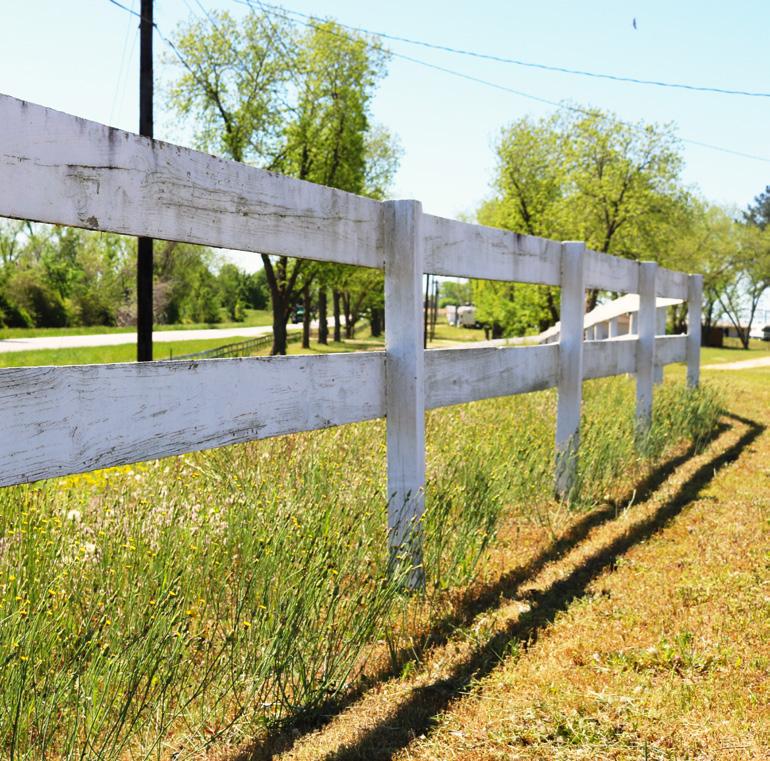


EXISTING | The home of Jim’s Bargain Barn, this building was selected to show the difference signage can make in the appearance of downtown commercial structures.
PROPOSED
This design concept shows the existing logo with a simplified script. Displayed in a traditional location along the storefront facade, this updated signage creates a more inviting and attractive business.

EXISTING | The public service annex at the corner of 1st and Jackson Street looks neglected and unmaintained. Brick sidewalks in this section of Jackson Street are deteriorating, with weeds and other debris littering the sidewalk.


PROPOSED Fresh paint where necessary and pressure washing refreshes the facade of this public building. Relocating the ADA parking space and removing the worn sign also updates the property. Local leaders could consider using convict trustee labor to repair and reset the brick sidewalk to improve pedestrian safety and neaten the streetscape. Reseeding the lawn and mulching existing trees would help clean up this property.
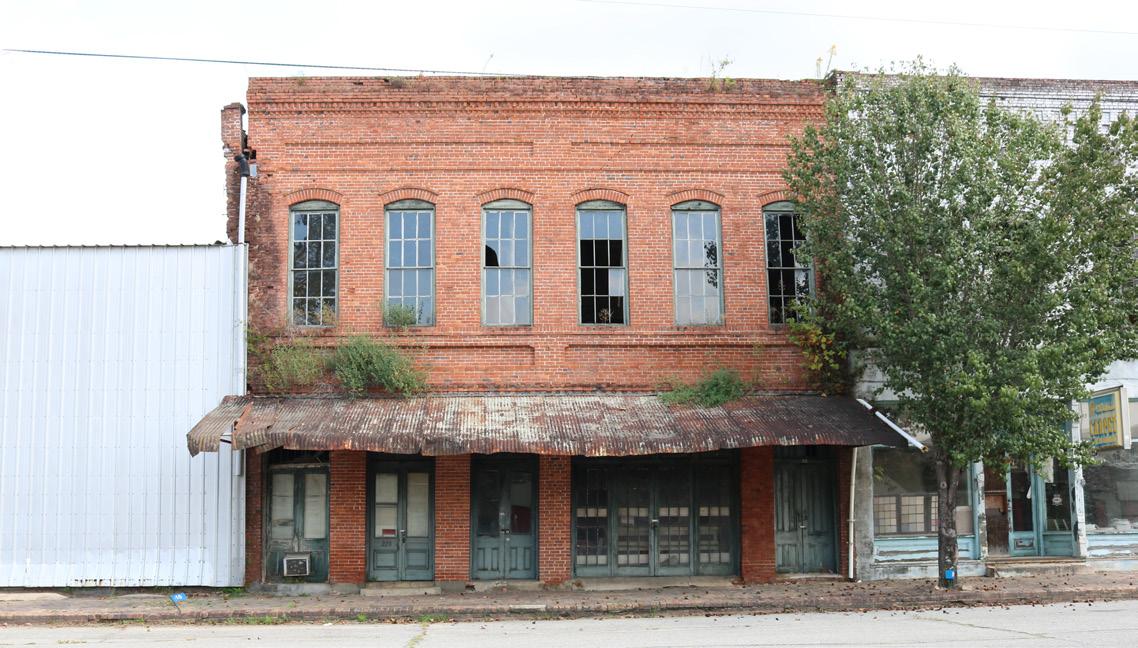
EXISTING | In urgent need of repair, the great bones and traditional craftsmanship of this historic structure at 20 North Broad Street lend irreplaceable character downtown. This and similar historic buildings risk being lost without immediate maintenance attention.

PROPOSED | This rendering shows the existing facade stabilized, with vegetation removed from the structure and windows and doors repaired. The adjacent blank wall was identified as a potential site for a branded mural promoting items made in Hawkinsville.
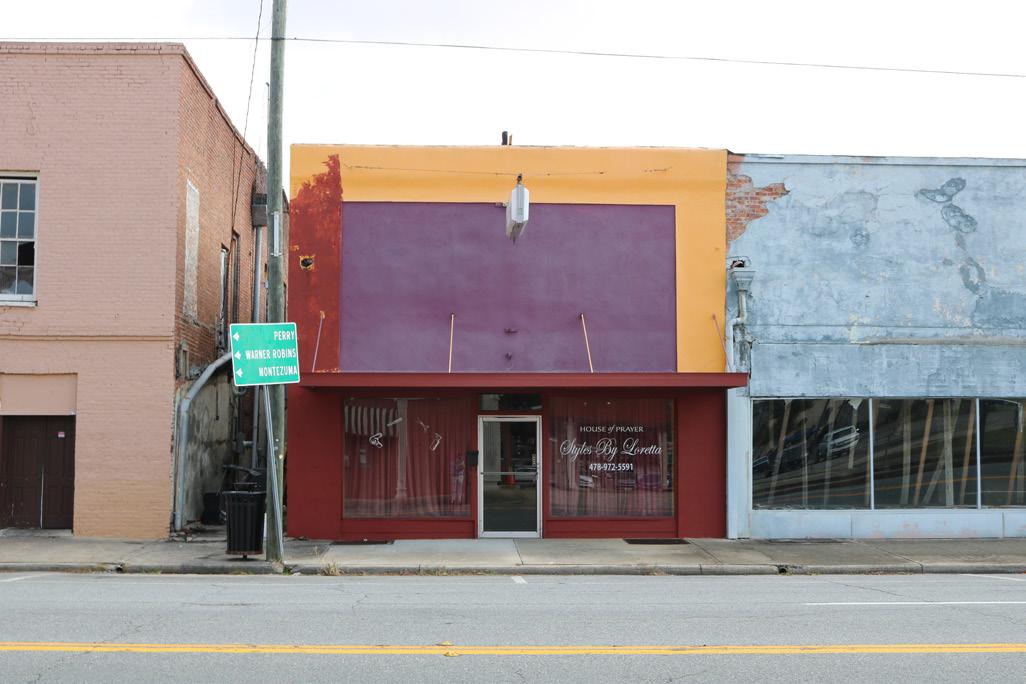
EXISTING | Located near the intersection with Commerce Street, the attractive form and midcentury elements of this stucco structure are hidden beneath mismatched paint.


PROPOSED Sage green paint and dark trim simplify the palette of this facade. A combination of clean midcentury san serif print and hand-painted signage lend a period-appropriate appearance to this storefront.

EXISTING | This deteriorating complex of buildings along Jackson Street is composed of several 1800s storefronts that were later combined into one structure.

PROPOSED
While the buildings could be beyond the point of being saved, retaining the storefronts could help preserve some elements of downtown’s historical character. The senior center shown is only a concept. The focus should be on preserving and using historic buildings.




EXISTING | This vacant site adjacent to Planters First Bank could provide the ideal location for future infill development.


PROPOSED This rendering shows this site transformed with infill development, streetscaping, and attractive street trees.



EXISTING | This corner service station could be improved to enhance the appearance of downtown. The owners of this property would like to expand their business.
PROPOSED
Drawing on the design of other service stations owned by the property owner, this concept helps bring more life to the street by expanding the building to the sidewalk. This designs also shows improved landscaping, on-street parking, new sidewalks, and street trees.

This site plan was developed to assist property owners interested in expanding their business on this prominent corner. This design helps bring more activity to Jackson Street and Sioux Place while expanding the pumping station and available parking.
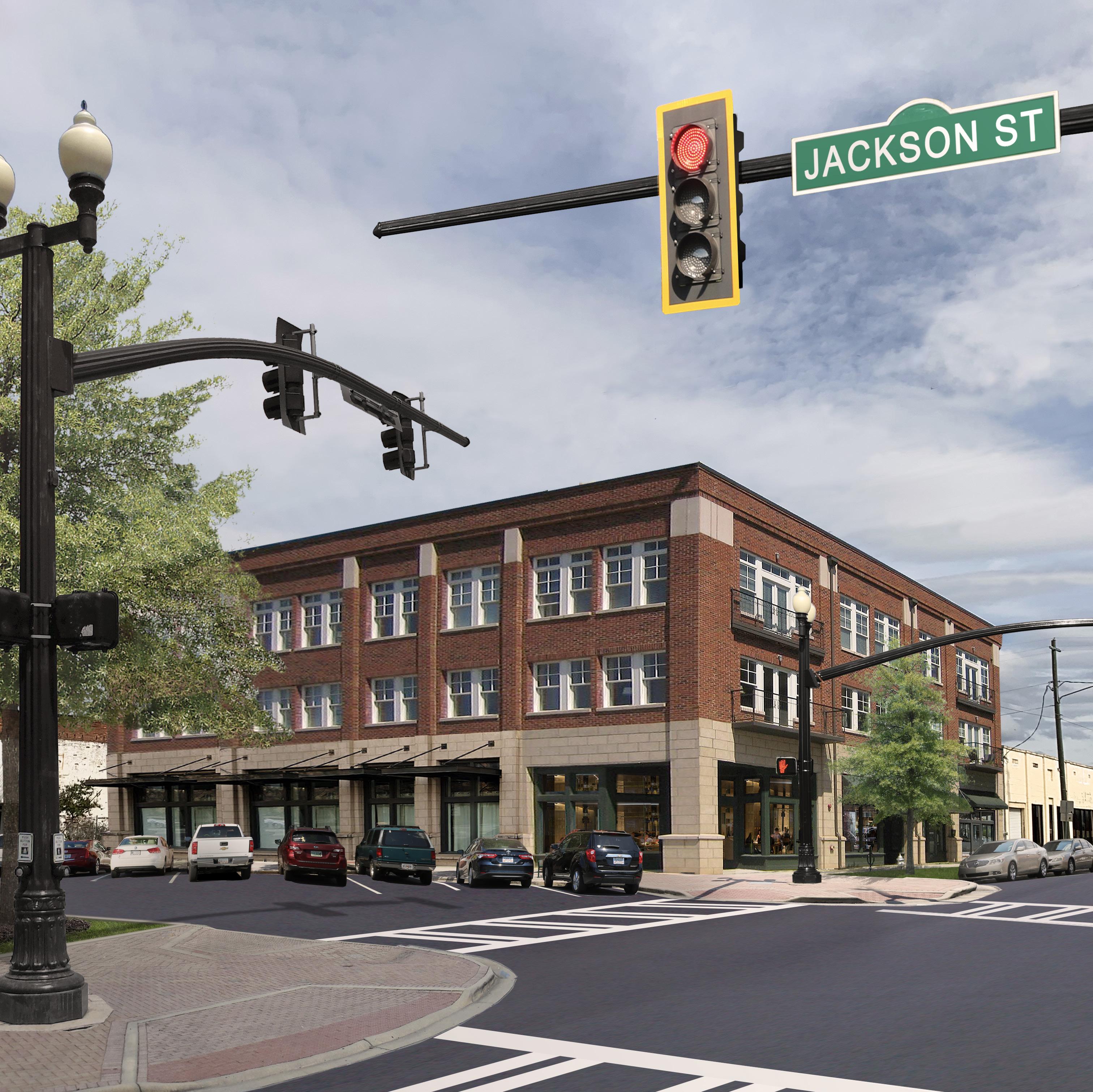
EXISTING | Until recently, the corner of Broad Street and Jackson Street housed a collection of vacant buildings. This complex was demolished in February 2021.

PROPOSED | Prioritizing this prominent site for infill development could help catalyze redevelopment along Jackson Street. This rendering shows a handsome three-story brick structure at this highly visible corner. Pictured with ground-floor storefronts, retail, or office use, and two floors of upper-story residences, such a design could bring new energy and a 24-hour population downtown. Additional improvements shown include new streetscaping elements like expanded bump-outs, angled parking, and attractive mast-arm traffic signals.
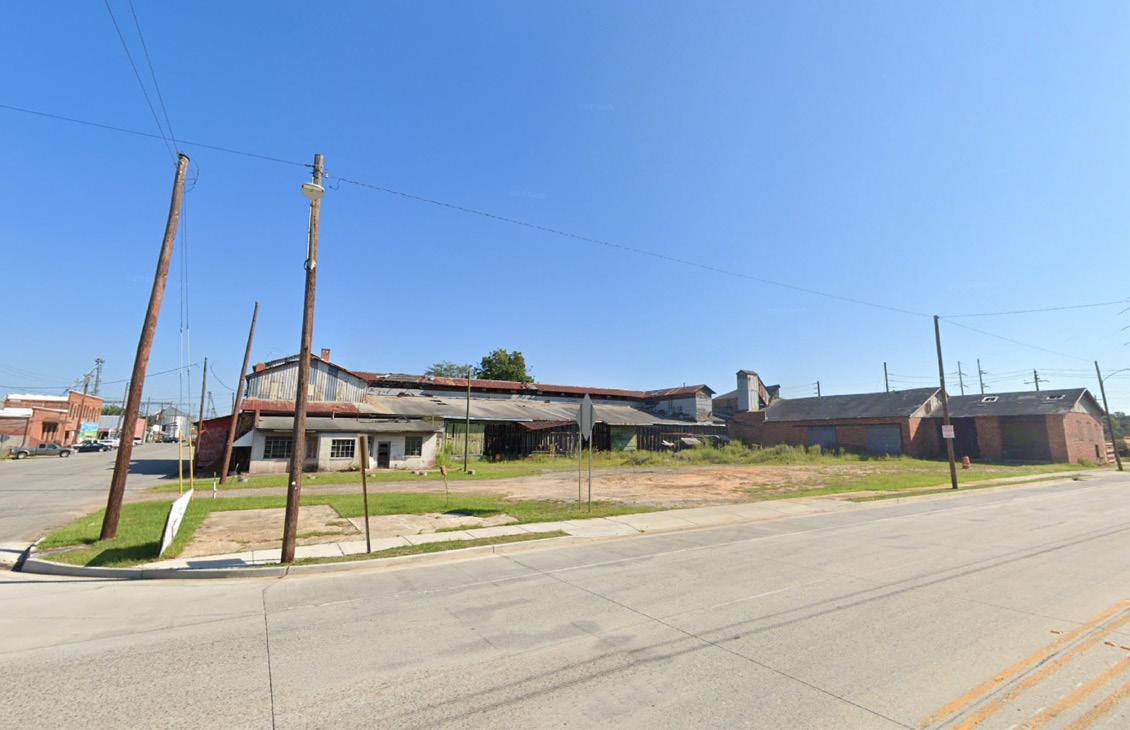
EXISTING | Currently housing a conglomeration of vacant former industrial buildings, this property has been acquired by the City of Hawkinsville for a new $3.5 million city hall complex.

PROPOSED | This rendering shows the existing design concept for Hawkinsville’s new city hall. Situated in a large, landscaped site and accentuated by handsome large-canopy oak trees, this development will drastically improve the appearance of the Broad Street corridor. Additional changes help improve downtown connectivity, including formalized on-street parking, accessible pedestrian crossings, and a crosswalk at Houston Street. Retained from the original structure, an 1800s-era arched masonry wall lends character to the site and helps link it with Veterans Park and the Ocmulgee River beyond.
Action Items

BUILDINGS: CONDITION & VACANCY
For Hawkinsville to realize the community’s vision for downtown, local leaders
must work to address vacancy and improve the condition of downtown buildings. Accomplishing these goals requires a mix of both incentives, or “carrots,” and enforcement mechanisms, known as “sticks.” The following action items highlight a number of strategies to address these issues. Arranged into the categories of “carrots” and “sticks,” these actions create a framework for the transformation of the city’s building stock and the revival of downtown.
TIMELINE Short Term (Six Months – Two Years)
Existing Incentives and Ordinances Education
Promote Rural Zone Incentives
From the facade grant program and low-interest loans to Hawkinsville’s designation as a Rural Zone, the city offers a variety of tools to encourage redevelopment. Local officials should work to spread the word about incentives in the community. Developing education in collaboration with the Middle Georgia Regional Commission could help instruct local officials and community members about the variety and application of available incentives. Guaranteeing that potential investors and business owners are aware of these programs and are able to access existing benefits is an essential first step in encouraging redevelopment.
LEAD: Sandy White, Hawkinsville–Pulaski County Economic Development PARTNERS: Middle Georgia Regional Commission, Hawkinsville DDA POTENTIAL ACTION STEPS:
1. Develop a list of existing incentives and programs, including the requirements necessary to apply, award maximums, receive funding, and more. 2. Contact potential speakers and subject matter experts from the Middle Georgia Regional Commission, the Georgia Department of Community Affairs, and more. 3. Contact local leaders and organize a meeting. 4. Hold the meeting with local leaders and the invite public. 5. Publicize the content of the meeting in the Hawkinsville Dispatch and News, on the city’s website, on social media accounts, and through other outlets.
TIMELINE
Short Term (Six Months –
Two Years) Announced in October 2020, Hawkinsville’s designation as a Rural Zone brings a variety of new incentives to downtown revitalization. This designation allows property owners to take advantage of tax credits to invest in and renovate downtown buildings. Local leaders should look to the example of prior Rural Zone communities, including Bainbridge, Georgia, to determine the best ways to promote the program and attract the type of redevelopment desired downtown. Developing a campaign to educate local officials, business owners, and potential investors on the benefits of Rural Zone designation would be beneficial.
LEAD: Sandy White, Hawkinsville–Pulaski County Economic Development
PARTNERS: Middle Georgia Regional Commission, Hawkinsville DDA
POTENTIAL ACTION STEPS:
1. Develop a list of existing incentives and programs, including the requirements necessary to apply, award maximums, receive funding, and more. 2. Contact potential speakers and subject matter experts from the Middle Georgia Regional Commission, the Georgia Department of Community Affairs, and more. 3. Contact local leaders and organize a meeting. 4. Hold the meeting with local leaders and the invite public. 5. Publicize the content of the meeting in the Hawkinsville Dispatch and News, on the city’s website, on social media accounts, and through other outlets.
TIMELINE Complete
DDA Site Visit to Bainbridge
Use the Main Street/Chamber Website to Market Downtown Development
Downtown development authorities possess wide authority to purchase, rehabilitate, lease, or sell buildings. To inspire and inform local board members, consider a site visit to downtown Bainbridge, Georgia. Bainbridge has successfully leveraged the powers of the DDA and incentives like the city’s Rural Zone designation to revitalize many formerly vacant downtown properties. Leaders of the Hawkinsville Downtown Development Authority should consider contacting Amanda Glover, the Bainbridge DDA director, and consulting the Bainbridge DDA on how best to utilize existing incentives.
LEAD: Ken Clark, Hawkinsville Downtown Development Authority PARTNERS: Hawkinsville–Pulaski County Economic Development, City of Bainbridge, Bainbridge DDA POTENTIAL ACTION STEPS:
LEAD: Sandy White, Hawkinsville–Pulaski County Economic Development PARTNERS: Middle Georgia Regional Commission
1. Contact Amanda Glover, Bainbridge DDA director. 2. Set up a virtual or in-person meeting to discuss Bainbridge’s experience using the powers of the DDA and incentives like the city’s Rural Zone designation to redevelop downtown. 3. Invite members of the local government and business community. 4. Conduct a meeting in-person or virtually. 5. Tour relevant project sites in downtown Bainbridge. 6. Publicize the tour, meeting, and lessons learned in the Hawkinsville Dispatch and News, on the city’s website, on social media accounts, and through other outlets.
TIMELINE Complete
To address downtown’s high vacancy rate and to market available buildings to investors, the city could promote existing incentives and successful redevelopment efforts while cataloguing vacant properties to showcase available buildings online. This catalog could include relevant contact information and even historic photographs of available buildings.
POTENTIAL ACTION STEPS: 1. Create a “success page” that shows images and information about recent redevelopment success stories downtown. 2. Promote the newly created downtown incentive booklet on the Main Street/Chamber website. 3. Work with student designers or a preferred local designer to develop a catalog of vacant properties. 4. Use the website to post the available property catalog online. 5. Advertise and promote vacant downtown properties to potential investors with relevant contact information. 6. Publicize links to the catalog on the city’s website and on social media platforms.
TIMELINE Short Term Capitalize on National Park Service Designation
(Six Months –
Two Years) Currently, much of downtown Hawkinsville is included in the Hawkinsville Commercial and Industrial Historic District. National Registry status grants access to certain tax benefits for rehabilitation and renovation of historic properties downtown. To leverage these benefits and promote them to downtown property owners, the city could consider retaining a tax credit consultant. Macon has used the city’s National Registry status and related tax incentives as an economic development tool. A historic tax credit consultant on retainer could assist downtown property owners with the appropriate paperwork and help guide interested investors through the process. Promote the Georgia Cities Foundation Revolving Loan Fund
LEAD: Sandy White, Hawkinsville–Pulaski County Economic Development PARTNERS: Hawkinsville DDA, Georgia Department of Natural Resources (DNR), National Park Service POTENTIAL ACTION STEPS:
1. Reach out to tax incentive specialists at Georgia DNR. 2. Learn whether existing programs are being used by local property owners. 3. Seek advice on potential tax credit consultants in the Macon area. 4. Consider contracting with a tax credit consultant to assist property owners with applying for and obtaining relevant tax credits. 5. Publicize the relationship with the tax consultant and invite property owners to take advantage of these services via the Hawkinsville Dispatch and News and on the city’s website and social media platforms.
TIMELINE Short Term (Six Months – Two Years)
The Georgia Cities Foundation’s revolving loan fund provides up to $200,000 for building rehabilitation, acquisition, and other activities. Structured through a local DDA, applications are evaluated based on leadership, accountability, long-term sustainability, and the potential for private investment. Projects should encourage spin-off development, add jobs, promote downtown housing, or add to the cultural enrichment of the community. Each application must also undergo credit underwriting. For more information, see www.georgiacitiesfoundation.org/Programs-Services/Revolving-Loan-Fund.aspx.
LEAD: Sandy White, Hawkinsville–Pulaski County Economic Development PARTNERS: Hawkinsville DDA POTENTIAL ACTION STEPS:
1. Reach out to specialists at the Georgia Cities Foundation and Georgia Municipal Association. 2. Request resources including articles with program information that could be republished locally to raise awareness of the Revolving Loan Fund and other programs. 3. Publish content in the Hawkinsville Dispatch and News and on the city’s website and social media platforms. 4. Advise and refer property owners to take advantage of the program.
TIMELINE Complete
Consider Applying for Opportunity Zone Status
Explore New Incentives to Attract Redevelopment
Administered through the Georgia Department of Community Affairs (DCA), the State Opportunity Zone program incentivizes investment in underserved communities through a job tax credit. This incentive is available to new and existing businesses in the form of a $3,500 tax credit for each new job created. Downtown Hawkinsville already meets the economic threshold required for State Opportunity Zone designation. In addition to a specified poverty level, eligible areas must also have an existing enterprise zone or urban redevelopment plan. Also administered in the state by DCA, the Federal Qualified Opportunity Zone program can be used to attract investment to underserved areas. To quality as a Federal Opportunity Zone, the community must meet certain economic restrictions and be nominated for designation by the state. Nominations are received for consideration by the secretary of the US Treasury through the Internal Revenue Service. Designations last for 10 years. If Hawkinsville is selected as a State Opportunity Zone, local leaders should consider applying for Federal Qualified Opportunity Zone status. LEAD: Sara Myers, City of Hawkinsville PARTNERS: City Clerk, City Attorney, City Commission POTENTIAL ACTION STEPS:
1. Contact Cherie Bennett at Georgia DCA to learn more about applying for State Opportunity Zone and Federal Qualified Opportunity Zone status [cherie.bennett@dca.ga.gov]. 2. Reach out to communities with State Opportunity Zones like Greensboro, Tifton, and Madison to learn about their experiences applying for the program. 3. Consider consulting leaders in Cochran, Vienna, and Dublin to learn more about their experiences. 4. Consult the DCA’s Opportunity Zone Application Checklist, gather the required information, and apply. 5. Apply for State Opportunity Zone Designation. 6. Consult DCA on additional steps necessary for Federal Qualified Opportunity Zone designation. 7. If successful, use State Opportunity Zone to request nomination as a Federal Qualified Opportunity Zone.
TIMELINE
Short Term (Six Months –
Two Years) With feedback from property owners, developers, and groups like Hawkinsville–Pulaski County Economic Development, Hawkinsville leaders should work to develop an incentives package for prospective redevelopment projects downtown. Through the Hawkinsville Downtown Development Authority, the city already offers local businesses incentives like facade grants and low-interest loans to encourage downtown redevelopment. The city should continue to work with the DDA and other groups to develop an ideal package of incentives that could be used to attract the high-quality downtown redevelopment envisioned by the community.
LEAD: Sandy White, Hawkinsville–Pulaski County Economic Development
PARTNERS: City of Hawkinsville, Chamber of Commerce, Hawkinsville DDA
POTENTIAL ACTION STEPS: 1. Contact local business and property owners to determine specific needs and requests. 2. As a starting point, consider roof grants and repointing/stabilization grants. 3. Continue to research incentives used by other cities and reach out to relevant city staff members and program managers to determine what programs have been successful elsewhere. 4. Consider using the general fund to support the new incentive program for first three years. 5. Consult the city attorney to determine if desired incentives are feasible locally. 6. Work with the Hawkinsville City Commission to establish desired local incentives. 7. Publish details and information on how to apply in the Hawkinsville Dispatch and News and on the city’s website and social media platforms.
TIMELINE Short Term (Six Months – Two Years)
Hawkinsville has successfully used facade grants as a tool to assist downtown property owners with building improvements. Promoting this program to downtown business owners could help quickly improve the appearance of many prominent downtown buildings. City leaders should consider expanding the existing façade grant program to provide more funding to property owners. Expanding the program to include the rear facades of businesses could also improve the appearance of downtown buildings. LEAD: Sandy White, Hawkinsville–Pulaski County Economic Development PARTNERS: City of Hawkinsville, Hawkinsville DDA POTENTIAL ACTION STEPS:
1. Reach out to tax incentive specialists at Georgia DNR. 2. Learn whether existing programs are being used by local property owners. 3. Seek advice on potential tax credit consultants in the Macon area. 4. Consider contracting with a tax credit consultant to assist property owners with applying for and obtaining relevant tax credits. 5. Publicize the relationship with the tax consultant and invite property owners to take advantage of these services via the Hawkinsville Dispatch and News and on the city’s website and social media platforms.
TIMELINE Short Term (Six Months – Two Years)
In addition to the need for substantial improvements like roofing and exterior repairs, many downtown business owners face regular costs associated with updating signage and awnings. The city could consider expanding the facade grant program to offset these costs. Using this expanded signage and awning grant could also help create a template for the type of signage and exteriors desired by community members. LEAD: Sandy White, Hawkinsville–Pulaski County Economic Development PARTNERS: City of Hawkinsville, Hawkinsville DDA POTENTIAL ACTION STEPS:
1. Contact local business and property owners to determine specific needs and requests. 2. Consider what funding sources could be applied to the expanded facade grant program. 3. Consult the city attorney to determine if expanding the existing facade grant is feasible locally. 4. Work with the Hawkinsville City Commission to establish desired local incentives. 5. Publish details and information on how to apply for facade grants in the Hawkinsville Dispatch and News and on the city’s website and social media platforms.
TIMELINE Medium Term Expand Grants for Sprinklers, Wiring, and Fire Code Updates
(Two – Four
Years) In addition to the costs of facade improvements, many owners interested in renovating historic downtown commercial buildings struggle to afford necessary property improvements like sprinklers and upper-story wiring. These updates are typically required to meet modern fire codes and safety standards. To encourage the rehabilitation of downtown buildings, Hawkinsville leaders should look to the example of other cities across the state and beyond. The downtown development authorities of both Dahlonega and Social Circle have invested in sprinkler grants to facilitate the restoration of downtown buildings and to attract upper-story residential development downtown.
With a maximum grant amount of $5,000, these programs offset up to 50% of the cost of new sprinkler systems. In both cities, these programs can also be used to offset costs associated with new wiring, commercial kitchen hood/vent construction, and more.
LEAD: Sandy White, Hawkinsville–Pulaski County Economic Development PARTNERS: City of Hawkinsville, Hawkinsville Downtown Development Authority POTENTIAL ACTION STEPS:
1. Consult downtown development authority directors in Dahlonega, Social Circle, and elsewhere to learn how different communities structure sprinkler grants. 2. Learn what funding sources other communities dedicate to sprinkler or wiring grants and consider what local funding sources could be applied to the program. 3. Consult the city attorney to determine if similar ordinances established elsewhere can be reworked to fit local conditions. 4. Work with the Hawkinsville City Commission to establish the desired incentives. 5. Publish details and information on how to apply for these grant programs in the Hawkinsville Dispatch and News and on the city’s website and social media platforms.
TIMELINE Medium Term Consider a Downtown Roof Replacement and Repair Grant
(Two – Four
Years) While demolition by neglect is typically seen as a willful strategy to minimize property investment, many property owners simply do not have the funds necessary to adequately maintain historic commercial properties. To support worthy property owners and stabilize downtown’s historic buildings, local leaders should consider more robust and direct assistance. Some cities have successfully stabilized downtown buildings with targeted grants. Rocky Mount, North Carolina, has developed a 50/50 matching grant with a maximum of $10,000 to assist downtown property owners with roof replacement and repair.
LEAD: Sandy White, Hawkinsville–Pulaski County Economic Development
PARTNERS: City of Hawkinsville, Chamber of Commerce, Hawkinsville DDA
POTENTIAL ACTION STEPS: 1. Consult downtown development authority directors in St. Marys, Georgia, and Rocky Mount, North Carolina, to learn how different communities structure roof replacement and repair grants. 2. Learn what funding sources other communities dedicate to roofing grants, and consider what local funding sources could be applied to the program. 3. Consult the city attorney to determine if establishing a similar ordinance locally would be advisable. 4. Work with the Hawkinsville City Commission to establish and fund this type of grant program. 5. Publish details and information on how to apply for a grant in the Hawkinsville Dispatch and News and on the city’s website and social media platforms.
(More than
four years) The Georgia Land Bank Act empowers local governments to create land banks. These quasi-governmental organizations can be used to acquire non-tax-producing vacant parcels with the goal of utilizing and restoring abandoned parcels. Local leaders should consider consulting the Center for Community Progress publication
Land Banks and Land Banking (2nd Edition), available at the Georgia Cities Foundation’s website, and reaching out to communities with successful land banks, including the Macon–Bibb County Land Bank Authority. Land banks in cities like St. Louis and Buffalo have developed programs to sell properties to new homeowners committed to renovation. Many of these properties are available for as little as $1 but require prospective property owners to rehabilitate the property and remain in the home for a minimum of three years.
LEAD: Sara Myers, City of Hawkinsville PARTNERS: Hawkinsville Downtown Development Authority, Hawkinsville–Pulaski County Economic Development, Georgia Municipal Association Trainings POTENTIAL ACTION STEPS: 1. Contact downtown development specialists at the Georgia Municipal Association and request more information. 2. Reach out to the Macon–Bibb County Land Bank Authority and/or Valdosta to determine the overall structure of that city’s successful land bank. 3. Continue to consult with successful outside land banks to determine best practices. 4. Determine whether a similar program would be viable locally. 5. Consider potential funding sources and how a land bank would be staffed and equipped. 6. Work with the Hawkinsville Downtown Development Authority to develop a similar program locally. 7. Consult the city attorney for assistance structuring a viable local land bank. 8. Work with the Hawkinsville City Commission to establish the land bank. 9. Appoint a land bank board of directors. 10.Publish information on the land bank’s structure, function, and purpose in the newspaper and city’s website. 11. Hold the first land bank meeting and develop a work plan. 12. Continue to promote the land bank to property owners and keep the program staffed and equipped.
TIMELINE Long Term Consider a Local Revolving Loan Fund for Downtown Redevelopment (More than Through this program, the DDA offers financial incentives to new and expanding downtown businesses. four years) Projects eligible for these funds must provide permanent employment and/or prevent or eliminate blight. Local revolving loan funds are created after a local government receives a Community Development Block Grant “Employment Incentive Program” or “Redevelopment Fund Program” grant. The revolving loan fund is then used to provide low-inter-est loans, leases, or other support to expand economic opportunities, principally for persons of low and moderate income.
LEAD: Sara Myers, City of Hawkinsville
PARTNERS: Hawkinsville DDA, Hawkinsville–Pulaski County Economic Development, Georgia DCA
POTENTIAL ACTION STEPS: 1. Contact Caroline Loos with the Georgia Department of Community Affairs, [caroline.loos@dca.ga.gov]. 2. Reach out to leaders of the Perry Downtown Development Authority to determine the overall structure. 3. If desired by the community, work with the Hawkinsville DDA to develop a similar program locally. 4. Consult the city attorney for assistance structuring a viable revolving loan fund. 5. Work with Hawkinsville City Commission to establish and fund a revolving loan fund. 6. Publish information on the program and how to apply in the Hawkinsville Dispatch and News and on the city’s website and social media platforms.
TIMELINE Short Term (Six Months – Two Years)
Continue Code Enforcement:
Develop Minimum Maintenance Standards
Addressing maintenance issues and vacancy requires the city to continue enforcing property maintenance standards. Often code enforcement relies on the will of elected officials to support the effort. Local leaders should work with the city’s Code Enforcement Office to notify property owners of existing maintenance standards. To ensure property owners are aware of existing standards, local enforcement officers could develop a list of common issues to circulate in the community. Moving forward, city leaders should ensure that the Code Enforcement Office remains staffed and adequately equipped to help resolve building maintenance issues.
To ensure that downtown buildings are stable and well maintained, property owners need a baseline standard of adequate maintenance. Madison, Georgia, has seen great success bringing new life to old buildings. Local leaders should consider looking at the minimum maintenance standards for downtown buildings included in Madison’s Code of Ordinances (Article V, Sec. 42-112). Working with the City Code Enforcement Office and the City Commission to develop a similar minimum maintenance standard acceptable to the community could help define best practices for property owners.
LEAD: Sara Myers, City of Hawkinsville PARTNERS: Jersey Bray, City Code Enforcement Officer, City Commission POTENTIAL ACTION STEPS:
1. Work with the City Code Enforcement Office to develop a list with images of common property violations downtown. 2. Distribute the common violations list to individual property owners and publicize the information in the Hawkinsville Dispatch and News, on the city’s website, and on social media platforms. 3. Reach out to property owners and alert them that the City Code Enforcement Office is active and empowered to give citations for violations. 4. Work with the Hawkinsville City Commission to ensure the Code Enforcement Office remains staffed and equipped. 5. Continue code enforcement.
TIMELINE Short Term (Six Months – Two Years)
LEAD: Sara Myers, City of Hawkinsville PARTNERS: City Commission, City Code Enforcement Office, Middle Georgia Regional Commission, City Clerk, City Attorney POTENTIAL ACTION STEPS:
1. Research minimum maintenance standards including those in Madison’s Code of Ordinances. 2. Reach out to planners at the Middle Georgia Regional Commission for additional examples. 3. Use information gathered in the block-by-block audit to note any specific maintenance issues in downtown Hawkinsville. 4. Work with the city clerk and city attorney to draft and apply minimum maintenance standards tailored to conditions in downtown Hawkinsville. 5. Propose any potential ordinance changes and revisions to the Hawkinsville City Commission.
TIMELINE Short Term Review and Update Codes to Address Issues
(Six Months –
Two Years) Conduct a general review of regulations and practices in Hawkinsville’s Code of Ordinances to target demolition by neglect and limit incompatible downtown uses like storage. Currently, much of downtown is zoned B-2, which prohibits storage as an appropriate use. However, portions of Hawkinsville’s traditional downtown along Commerce Street are zoned I or Industrial. In these areas, storage is allowed and new storage buildings or other, more noxious property uses could be constructed tomorrow. Because the primary downtown zoning,
B-2, extends to surrounding areas, uses like fast food are currently permitted. Local leaders should review existing ordinances to ensure they make sense in a traditional downtown area. Storage and other incompatible uses are not appropriate in
Hawkinsville’s downtown core. During the ordinance review, consider any issues that contribute to demolition by neglect.
A thorough review of existing ordinances could also help remove potential roadblocks to redevelopment and reveal any outdated ordinances that are no longer beneficial for the community.
LEAD: Sara Myers, City of Hawkinsville
PARTNERS: City Clerk, City Attorney, City Commission
POTENTIAL ACTION STEPS:
1. Work with the city clerk and city attorney to review the Hawkinsville Code of Ordinances. 2. During this review of existing ordinances, note areas like conditional uses that allow for downtown storage or demolition by neglect. 3. During the review, note any outdated ordinances or codes in the city’s Site Design Standards that could hinder downtown redevelopment. • Examine required parking, square footage minimums, and other restrictions to ensure they make sense for downtown. 4. Research communities with downtown business district, downtown district, or central business district (CBD) zoning. Consider what uses and standards these communities follow and how they could be adapted to conditions in Hawkinsville. 5. Working with the city attorney, propose potential changes. 6. Reach out to any city departments affected by the proposed ordinance changes to ensure they are viable. 7. Propose any finalized ordinance changes and revisions to the Hawkinsville City Commission.
TIMELINE Short Term Include a Maintenance Covenant on Façade Grants
(Six Months –
Two Years) Hawkinsville’s facade grant program is an important tool to improve the appearance and maintenance of downtown buildings. In any new facade grants, the city could consider including a covenant requiring continued maintenance of the facade and the building. Used widely in cities and neighborhoods throughout Georgia, covenants help ensure that any improvements funded in part by local taxpayers are adequately maintained and beneficial to the community.
LEAD: Ken Clark, Hawkinsville Downtown Development Authority PARTNERS: City of Hawkinsville, City Attorney POTENTIAL ACTION STEPS: 1. Research maintenance covenants used in facade grants elsewhere. 2. Reach out to representatives from the Department of Community Affairs and the Middle Georgia Regional
Commission for examples of maintenance covenants used in facade grants in other communities. 3. Use information gathered in the block-by-block audit to note any outstanding maintenance issues on buildings that have received facade grants. 4. Work with the city clerk and attorney to draft a maintenance covenant that addresses issues. 5. Include the proposed maintenance covenant in future facade grants.
TIMELINE Medium Term (Two – Four Years)
Consider an Annual Registration of Vacant and Abandoned Properties
Many cities across the state struggle with vacant and neglected downtown buildings. Powder Springs took an innovative approach requiring property owners to register vacant property to help protect neighborhoods from blight. While assisting with code enforcement and creating an inventory of underutilized property, these ordinances are generally drafted to encourage properties to be kept in safe and inhabitable condition. These registries often require a fee for registration and a larger penalty if property owners fail to register properties. Powder Springs has been particularly successful in the development and application of that city’s vacant property registry. Powder Springs requires a $1,000 annual registration fee for vacant property. Following the first year of vacancy, this fee increases $200 annually. These funds are eventually returned to the property owner if the building can be filled and certified as free of code violations. For more information, see Powder Springs’ Ordinance 2016-033 in the appendix of this document. The Georgia Cities Foundation has also developed a model ordinance for targeting derelict and blighted property. This ordinance, and other redevelopment tools, are available on the Foundation’s digital Blight & Redevelopment Toolkit. See the Georgia Cities Foundation’s website for more information: www.gacities.com/Trending-Topics/Blight-Redevelopment-Toolkit.aspx LEAD: Sara Myers, City of Hawkinsville PARTNERS: City Clerk, City Attorney, City Commission POTENTIAL ACTION STEPS:
1. Reach out to Power Springs city staff to learn from their experience creating and enforcing a vacant property registry. 2. Research additional examples elsewhere and consider contacting downtown development specialists at the Georgia Municipal Association/Georgia Cities Foundation for more information. 3. Work with the city clerk and attorney to craft a vacant and abandoned property registry tailored to downtown. 4. Use information from the block-by-block audit to notify property owners of potential ordinance changes. 5. Determine an appropriate registration fee and date for the ordinance to take effect. 6. Propose potential ordinance changes to the Hawkinsville City Commission.
TIMELINE Medium Term (Two – Four Consider a Blight Tax
Years) The Georgia Constitution empowers local governments to selectively raise millage rates on blighted property through procedures and standards defined by local ordinances. Statesboro recently approved a blight tax that taxes blighted property at eight times the city’s existing millage rate. Cornelia’s blight tax, included in the city’s Community Redevelopment Tax Incentive Program, has been widely cited for its success encouraging reinvestment downtown. Jasper County and other local governments have used Cornelia’s blight tax as a model ordinance to guide the implementation of their own local standards and procedures. A copy of Cornelia’s ordinance is included in the appendix of this document for the consideration of local leaders. 1. Reach out to Power Springs city staff to learn from their experience creating and enforcing a vacant property registry. 2. Research additional examples elsewhere and consider contacting downtown development specialists at the Georgia Municipal Association/Georgia Cities Foundation for more information. 3. Work with the city clerk and attorney to craft a vacant and abandoned property registry tailored to downtown. 4. Use information from the block-by-block audit to notify property owners of potential ordinance changes. 5. Determine an appropriate registration fee and date for the ordinance to take effect. 6. Propose potential ordinance changes to the Hawkinsville City Commission.
LEAD: Sara Myers, City of Hawkinsville PARTNERS: City Clerk, City Attorney, City Commission POTENTIAL ACTION STEPS:






